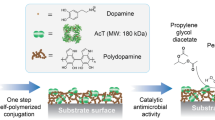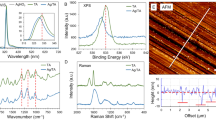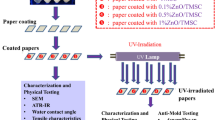Abstract
Phenoxy-substituted phthalocyanine zinc (PPcZn) was synthesized and used as a photosensitizer to prepare a variety of self-disinfecting films by incorporating it into a cellulose acetate (CA) film at various concentrations. The generation of singlet oxygen (1O2) from the films containing PPcZn irradiated with visible light was detected by a film containing 1,3-diphenylisobenzofuran (DPBF). The rate of 1O2 generation followed a pseudofirst-order kinetic model. Antiviral activity was confirmed under visible light irradiation using Bacteriophage Qβ. The film exhibited superior water resistance, photostability, mechanical strength, and sustained 1O2 production over 6 months under continuous exposure to room light. These data show the promise of this film in real-life applications as self-disinfecting surfaces.
This is a preview of subscription content, access via your institution
Access options
Subscribe to this journal
Receive 12 print issues and online access
$259.00 per year
only $21.58 per issue
Buy this article
- Purchase on Springer Link
- Instant access to full article PDF
Prices may be subject to local taxes which are calculated during checkout








Similar content being viewed by others
References
Biyiklioglu Z, Ozturk I, Arslan T, Tunçel A, Ocakoglu K, Hosgor-Limoncu M. et al. Synthesis and antimicrobial photodynamic activities of axially {4-[(1E)-3-oxo-3-(2-thienyl)prop-1-en-1-yl]phenoxy} groups substituted silicon phthalocyanine, subphthalocyanine on Gram-positive and Gram-negative bacteria. Dye Pigment. 2019;166:149–58.
Gomez-Rios D, Ramirez-Malule H. Bibliometric analysis of recent research on multidrug and antibiotics resistance (2017–2018). J Appl Pharm Sci. 2019;9:112–6.
Nakonechny F, Barel M, David A, Koretz S, Litvak B, Ragozin E, et al. Dark Antibacterial Activity of Rose Bengal. Int J Mol Sci. 2019;20. https://doi.org/10.3390/ijms20133196.
Baigorria E, Milanesio ME, Durantini EN. Synthesis, spectroscopic properties and photodynamic activity of Zn(II) phthalocyanine-polymer conjugates as antimicrobial agents. Eur Poly J. 2020;134. https://doi.org/10.1016/j.eurpolymj.2020.109816.
Schäfer M, Schmitz C, Facius R, Hormeck G, Milow B, Funken KH, et al. Systematic Study of Parameters Influencing the Action of Rose Bengal With Visible Light on Bacterial Cells: Comparison Between the Biological Effect and Singlet-Oxygen Production. Photochem Photobiol. 2000;71:514.
Walker T, Canales M, Noimark S, Page K, Parkin I, Faull J, et al. Antimicrobial Surface Is Active Against Bacterial, Viral and Fungal Organisms. Sci Rep. 2017;7:15298.
Weng D, Qi H, Wu TT, Yan M, Sun R, Lu Y. Visible light powered self-disinfecting coatings for influenza viruses. Nanoscale. 2012;4:2870–4.
Korneev D, Kurskaya O, Sharshov K, Eastwood J, Strakhovskaya M. Ultrastructural Aspects of Photodynamic Inactivation of Highly Pathogenic Avian H5N8 Influenza Virus. Viruses. 2019;11:955.
Tavares A, Carvalho CM, Faustino MA, Neves MG, Tome JP, Tome AC, et al. Antimicrobial photodynamic therapy: study of bacterial recovery viability and potential development of resistance after treatment. Mar Drugs. 2010;8:91–105.
Kashef N, Hamblin MR. Can microbial cells develop resistance to oxidative stress in antimicrobial photodynamic inactivation? Drug Resist Updat. 2017;31:31–42.
Noimark S, Dunnill CW, Parkin IP. Shining light on materials–a self-sterilising revolution. Adv Drug Deliv Rev. 2013;65:570–80.
Forte Giacobone AF, Ruiz Gale MF, Hogert EN, Oppezzo OJ. A possible phenomenon of persistence in Pseudomonas aeruginosa treated with methylene blue and red light. Photochem Photobio. 2016;92:702–7.
Weber DJ, Rutala WA. Self-disinfecting surfaces: review of current methodologies and future prospects. Am J Infect Control. 2013;41:531–5.
Querido MM, Aguiar L, Neves P, Pereira CC, Teixeira JP. Self-disinfecting surfaces and infection control. Colloids Surf B Biointerfaces. 2019;178:8–21.
Page K, Wilson M, Parkin IP. Antimicrobial surfaces and their potential in reducing the role of the inanimate environment in the incidence of hospital-acquired infections. J Mater Chem. 2009;19:3819.
Mesquita MQ, Dias CJ, Neves MGPMS, Almeida A, Faustino MAF. Revisiting current photoactive materials for antimicrobial photodynamic therapy. Molecules. 2018;23:2424.
Bhatti M, MacRobert A, Meghji S, Henderson B, Wilson M. A study of the uptake of toluidine blue O by Porphyromonas gingivalis and the mechanism of lethal photosensitization. Photochem Photobiol. 1998;68:370–6.
Wainwright M. Acridine-a neglected antibacterial chromophore. J Antimicrob Chemother. 2001;47:1–13.
Carpenter BL, Scholle F, Sadeghifar H, Francis AJ, Boltersdorf J, Weare WW, et al. Synthesis, characterization, and antimicrobial efficacy of photomicrobicidal cellulose paper. Biomacromolecules. 2015;16:2482–92.
Moreira LM, Santos FV, Lyon JP, Maftoum-Costa M, Pacheco-Soares C, Silva NS. Photodynamic therapy: porphyrins and phthalocyanines as photosensitizers. Aust J Chem. 2008;61:741–54.
George L, Müller A, Röder B, Santala V, Efimov A. Photodynamic self–disinfecting surface using pyridinium phthalocyanine. Dyes Pigments. 2017;147:334–42.
Grammatikova NE, George L, Ahmed Z, Candeias NR, Durandin NA, Efimov A. Zinc phthalocyanine activated by conventional indoor light makes a highly efficient antimicrobial material from regular cellulose. J Mater Chem B. 2019;7:4379–84.
Lamberts JJM, Schumacher DR, Neckers DC. Novel rose bengal derivatives: synthesis and quantum yield studies. J Am Chem Soc. 1984;106:5879–83.
Decraene VR, Pratten J, Wilson M. Cellulose acetate containing toluidine blue and rose bengal is an effective antimicrobial coating when exposed to white light. Appl Environ Microbiol. 2006;72:4436–9.
Decraene V, Pratten J, Wilson M. Assessment of the activity of a novel light-activated antimicrobial coating in a clinical environment. Infect Control Hosp Epidemiol 2008;29:1181.
Nassar SJM, Wills C, Harriman A. Inhibition of the photobleaching of methylene blue by association with urea. ChemPhotoChem. 2019;3:1042–9.
Robinson-Duggon J, Marino-Ocampo N, Barrias P, Zuniga-Nunez D, Gunther G, Edwards AM, et al. Mechanism of visible-light photooxidative demethylation of toluidine blue O. J Phys Chem A. 2019;123:4863–72.
Gerdes R, Bartels O, Schnider G, Wöhrle D, Schulz-Ekloff G. Photooxidations of phenol, cyclopentadiene and citronellol with photosensitizers ionically bound at a polymeric ion exchanger. Polym Adv Technol. 2001;12:152–16.
Kenley RA, Kirshen NA, Mill T. Photooxidation of Di-n-butyl sulfide using sensitizers immobilized in polymer films. Macromolecules. 1980;13:808–15.
Lyutakov O, Hejna O, Solovyev A, Kalachyova Y, Svorcik V. Polymethylmethacrylate doped with porphyrin and silver nanoparticles as light-activated antimicrobial material. RSC Adv. 2014;4:50624–30.
Bonnett R, Buckley DG, Burrow T, Galia ABB, Saville E, Songca SP. Photobactericidal materials based on porphyrins and phthalocyanines. J Mater Chem. 1993;3:323–4.
Makhseed S, Al-Sawah M, Samuel J, Manaa H. Synthesis, characterization and nonlinear optical properties of nonaggregating hexadeca-substituted phthalocyanines. Tetrahedron Lett. 2009;50:165–8.
Zhang X-F, Xi Q, Zhao J. Fluorescent and triplet state photoactive J-type phthalocyanine nano assemblies: controlled formation and photosensitizing properties. J Mater Chem. 2010;20:6726–33.
Kucinska M, Skupin-Mrugalska P, Szczolko W, Sobotta L, Sciepura M, Tykarska E, et al. Phthalocyanine derivatives possessing 2-(morpholin-4-yl)ethoxy groups as potential agents for photodynamic therapy. J Med Chem. 2015;58:2240–55.
Trashin S, Rahemi V, Ramji K, Neven L, Gorun SM, De Wael K. Singlet oxygen-based electrosensing by molecular photosensitizers. Nat Commun. 2017;8. https://doi.org/10.1038/ncomms16108.
Zhdankin VV, Nemykin VN, Lukyanets EA. Synthesis of substituted phthalocyanines. Arkivoc. 2010;2010:136–208.
Entradas T, Waldron S, Volk M. The detection sensitivity of commonly used singlet oxygen probes in aqueous environments. J Photochem Photobio B. 2020;204:111787.
Harada N, Kataoka M, Nakanosho M, Uyama H. Penetration of singlet oxygen into films with oxygen permeability coefficient close to that of skin. Photochem Photobiol. https://doi.org/10.1111/php.13446 (in the press).
Revuelta-Maza MA, Nonell S, de la Torre G, Torres T. Boosting the singlet oxygen photosensitization abilities of Zn(ii) phthalocyanines through functionalization with bulky fluorinated substituents. Org Biomol Chem. 2019;17:7448–54.
Nakamura J, Miyoshi Y, Masuda G, Aoki M. Curable resin composition for imaging element and application thereof, JP6251530B2, 2017.
Litman Y, Rodriguez HB, San Roman E. Tuning the concentration of dye loaded polymer films for maximum photosensitization efficiency: phloxine B in poly(2-hydroxyethyl methacrylate). Photochem Photobio Sci. 2016;15:80–5.
Zhang XF, Xu HJ. Influence of halogenation and aggregation on photosensitizing properties of zinc phthalocyanine (ZnPC). J Chem Soc Faraday Trans. 1993;89:3347–51.
Chidawanyika W, Ogunsipe A, Nyokong T. Syntheses and photophysics of new phthalocyanine derivatives of zinc, cadmium and mercury. N. J Chem. 2007;31:377–84.
George S, Kishen A. Photophysical, photochemical, and photobiological characterization of methylene blue formulations for light-activated root canal disinfection. J Biomed Opt. 2007;12:034029.
Pena Luengas SL, Marin GH, Aviles K, Cruz Acuna R, Roque G, Rodriguez Nieto F, et al. Enhanced singlet oxygen production by photodynamic therapy and a novel method for its intracellular measurement. Cancer Biother Radiopharm. 2014;29:435–43.
Wang P, Qin F, Zhang Z, Cao W. Quantitative monitoring of the level of singlet oxygen using luminescence spectra of phosphorescent photosensitizer. Opt Express. 2015;23:22991–3003.
Akarsu E, Uslu R. Light-activated hybrid organic/inorganic antimicrobial coatings. J Sol-Gel Sci Technol. 2018;87:183–94.
Author information
Authors and Affiliations
Corresponding authors
Ethics declarations
Conflict of interest
The authors declare no competing interests.
Additional information
Publisher’s note Springer Nature remains neutral with regard to jurisdictional claims in published maps and institutional affiliations.
Supplementary information
Rights and permissions
About this article
Cite this article
Harada, N., Masuda, K., Nakamura, Ji. et al. Fabrication and evaluation of durable, optically clear, and self-disinfecting films. Polym J 53, 1383–1391 (2021). https://doi.org/10.1038/s41428-021-00532-9
Received:
Revised:
Accepted:
Published:
Issue Date:
DOI: https://doi.org/10.1038/s41428-021-00532-9



